Question: Is there any research on the TM technique and immunity?
Dr. Orme-Johnson: Yes. Studies show that practicing the Transcendental Meditation technique can be effective in strengthening the immune system.
Here’s a quick overview of the TM research on immunity. We’ll discuss the scientific studies for each as we get into the details:
1. TM practice produces a unique neurophysiological state of restful alertness that is the opposite of stress and facilitates the body’s self-repair mechanisms.1-15
2. Many TM practitioners have shown higher levels of circulating white blood cells that fight infection than control subjects who do not practice the TM technique.16

Many TM practitioners have higher levels of circulating white blood cells, which fight infection
3. TM practice has been effective in helping patients with HIV infections.17,18
4. Hospitalization rates for many TM practitioners were lower than for others in all categories of disease and 73 percent lower for nose, throat, and lung diseases.19,20
5. TM practice dramatically reduced hospitalization rates for elderly patients compared to controls.19,20
6. TM practitioners over 65 decreased their need for health care 14 percent per year on average, relative to controls, reaching a 70 percent reduction after five years of TM practice.21
7. The health benefits of TM practice often begin as soon as it is learned, providing evidence that the TM technique is the cause.21
Research has shown that the benefits of the TM technique are proportional to regularity of practice, so be regular with twice-a-day TM practice. For more information, see my Enjoy TM News article “How Important Is It to Practice TM Regularly? What the Research Tells Us.”
Research has shown that the benefits of the TM technique are proportional to regularity of practice, so be regular with twice-a-day TM practice.
Q: How can practicing the TM technique accomplish all this?
A: TM practice strengthens our physiology by providing a unique state of restful alertness that facilitates the body’s self-repair mechanisms.
This state of rejuvenating rest is different from ordinary waking, sleep, and dreaming states, and also from the changes produced by other types of meditation.1 TM practice allows the body’s self-healing mechanisms to work more effectively, which has significant health benefits.
The unique characteristics of restful alertness during TM practice are evident in both the brain and peripheral nervous system. First, let’s see what happens in the brain.
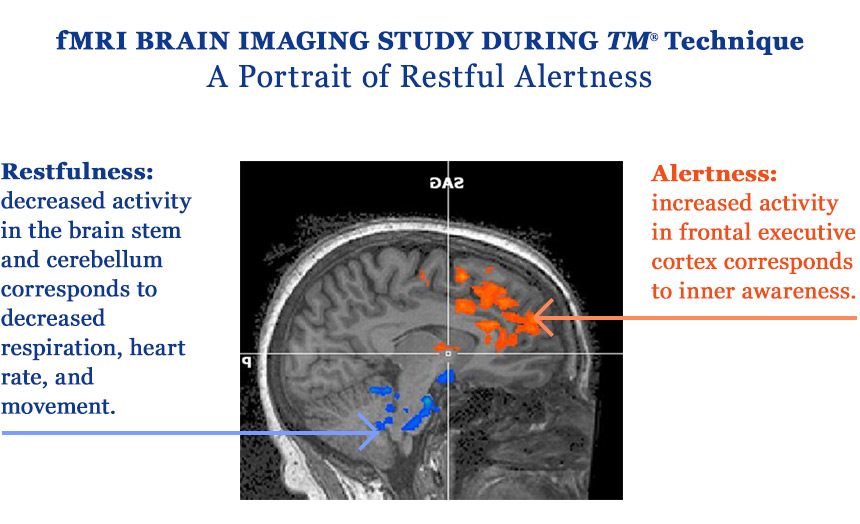
Reference. M. C. Mahone, Travis F., Gevirtz R., Hubbard D. “fMRI during Transcendental Meditation Practice.” Brain and Cognition (Epub, March 2, 2018).
Functional Magnetic Resonance Imaging (fMRI) shows changes in blood flow in the brain, which corresponds to changes in activity. During TM practice, blood flow to the control centers for vital functions located in the brain stem (shown in blue) decreases, which corresponds to the slower breathing and decreased heart rate that are observed during TM.
Blood flow also decreases in the cerebellum, which corresponds to increased relaxation of the body.
At the same time, inner awareness and alertness increase, corresponding to increased blood flow in the executive frontal brain areas (shown in red).2
Alertness during TM practice is also indicated by increases in brain waves in the alpha1 range (8-9 Hz, EEG). This indicates that the TM practitioner is relaxed, with expansive inner awareness.3-5
TM practice strengthens our physiology by providing a unique state of restful alertness that facilitates the body’s self-repair mechanisms.
Q: Is the rest gained during the TM technique different than other kinds of rest or relaxation?
A: Yes, it is much deeper. A meta-analysis of 32 studies6 comparing TM practice with ordinary rest (e.g. sitting with eyes closed) found significantly greater reductions in an array of measures that indicate deep rest, including:
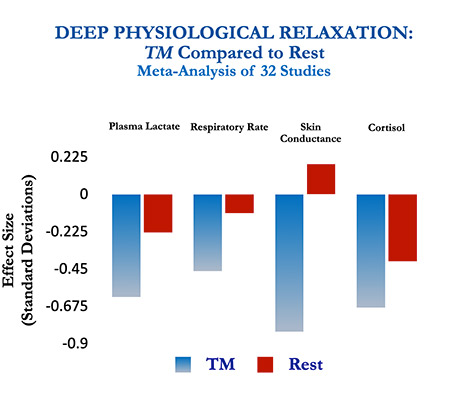
Reference. M. C. Dillbeck, and D. W. Orme-Johnson. “Physiological Differences between Transcendental Meditation and Rest.” American Psychologist 42 (1987): 879–881.
1. decreased plasma lactate (a metabolic by-product), which indicates rejuvenation of the body
2. decreased breath rate, which indicates a more relaxed physiology
3. decreased skin conductance, an indicator that stress is decreasing
4. decreased cortisol, a major stress hormone, indicating a holistic reduction in the stress response.
During TM practice, stress decreases. With regular, twice-daily practice, the body spontaneously maintains a more stress-free style of functioning after meditation as well.
TM practitioners become calmer, leaving more adaptive resources available for coping with life’s stressors.
TM practitioners become calmer, leaving more adaptive resources available for coping with life’s stressors.
Q: You mentioned that the brain functions more “coherently” during TM. What does this mean, and does it have any effect on immunity?
A: Numerous studies have shown that the EEG brain activity during TM practice is coherent. This means that the brain waves are synchronous with each other, indicating more integrated functioning of the brain, such as between the left and right hemispheres.7-11 This coherence occurs across a wide range of frequencies: alpha (8–12 Hz) and broadband (8–45 Hz).

Brain wave coherence means increased orderliness of brain functioning, with different areas of the brain working together more holistically. This chart shows results from many studies on the TM technique, illustrating the increase in EEG coherence in measures associated with a broad range of cognitive, affective, and physiological benefits. (References)
The increased alpha EEG coherence produced by the TM technique is correlated with increased intelligence, creativity, and memory, as well as with improved motor behavior. It is also correlated with reductions in anxiety and increased emotional stability.12–15 This increased calm and mental clarity helps us to make healthier lifestyle choices.
Increased calm and mental clarity helps us to make healthier lifestyle choices.
Q: Are there ways to directly test the level of immunity in people who practice TM?
A: Several peer-reviewed studies have shown that TM practitioners get sick less often and do not age as quickly as people who do not practice the TM technique, leading researchers to conclude that TM strengthens the immune system.
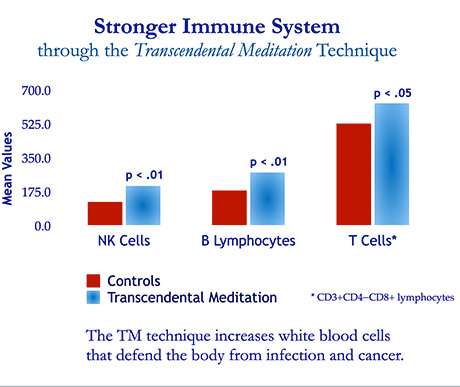
Reference. J. R. Infante, Peran F., Rayo J. I., et al. “Levels of immune cells in Transcendental Meditation practitioners.” International Journal of Yoga 7, no. 2 (2014): 147-151.
One of these studies looked specifically at immunity and found that TM practitioners have a stronger immune system than non-practitioners.
This result was due to higher levels of circulating lymphocytes, which protect the body from infection.
The study compared healthy, non-meditating control subjects to healthy TM practitioners, who had more:
1. T cells (CD3+CD4−CD8+ lymphocytes), which destroy infected and tumor cells
2. B lymphocytes, which identify and neutralize foreign objects, such as bacteria and viruses
3. natural killer cells, which provide rapid response to infected cells and tumor formation.16
At least one study has shown that TM practitioners have a stronger immune system than non-practitioners.
Q: Has TM been used to help in treating HIV?
A: That’s a good question, and similar to one that guided a study of people living with HIV. The subjects in this study were living with human immunodeficiency virus (HIV) and were stable on anti-retroviral treatment.
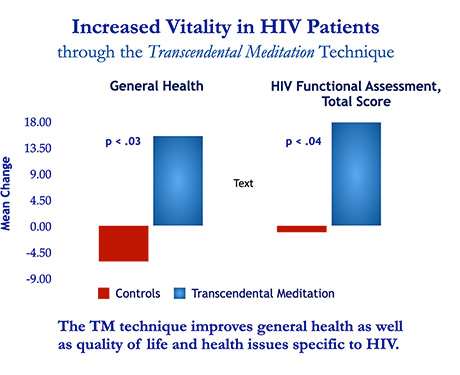
Reference. S. Chhatre, Metzger D. S., Frank I., et al. “Effects of Behavioral Stress Reduction Transcendental Meditation Intervention in Persons with HIV.” AIDS Care 25, no. 10 (2013): 1291–1297.
The researchers asked, “Would the addition of the TM technique to standard treatment help the patients?”
The TM group was compared to a control group that added healthy eating to their treatment program. The study found that the addition of TM practice to the anti-retroviral treatment significantly improved the patients’ general health as well as HIV functional assessment scores.
These scores revealed improvements in quality of life, including more energy, less nausea, less pain, feeling less ill, less coughing, less side effects from treatment, and greater ability to meet the needs of one’s family. 17-18
The addition of TM practice to the anti-retroviral treatment significantly improved the patients’ general health as well as HIV functional assessment scores.
Q: Have any studies shown that TM practitioners are less susceptible to diseases?
A: One way researchers try to answer a question like this is to examine health care utilization. A five-year study was conducted on the health insurance statistics of 2,000 people practicing the Transcendental Meditation technique.19
The rates of medical utilization by the TM group are shown by blue bars in the “Study 1” chart. Compared to the normative data for all 600,000 people insured by the company, called “Other Groups” (red bars), the TM group had lower hospitalization rates in all categories of disease.
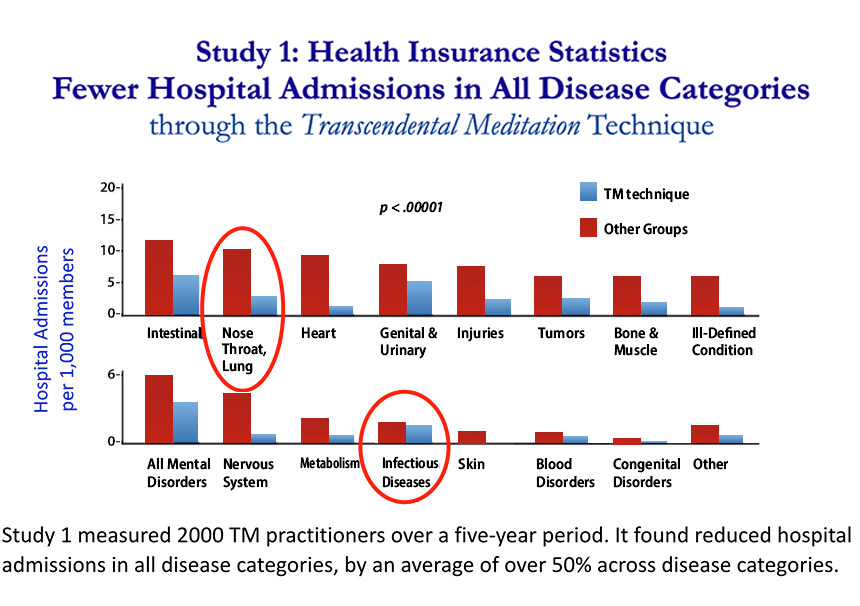
Reference. D. W. Orme-Johnson. “Medical Care Utilization and the Transcendental Meditation Program.” Psychosomatic Medicine 49 (1987): 493-507. Data courtesy of Blue Cross Blue Shield of Iowa.
The TM group had a 50 percent lower hospitalization rate across all disease categories than the norm for all others. The reduction for infections was even larger: 73 percent for the category of “Nose, Throat, and Lungs” (circled in the chart).
This category includes many diseases caused by viruses and bacteria, such as common colds, sinusitis (infection of the sinuses), pharyngitis (sore throat), pneumonia (inflammation of one or both lungs), and bronchitis (inflammation of the bronchial tubes).
For the category of “Infectious Diseases” (also circled in red), the TM group had a 30.4 percent lower hospitalization rate. This category includes infections such as polio, chickenpox, herpes, measles, and hepatitis.
The TM group had a 50 percent lower hospitalization rate across all disease categories than the norm for all others. The reduction for infections was even larger: 73 percent for the category of “Nose, Throat, and Lungs.”
Q: How can the single, simple technique of TM improve these and all kinds of diseases?
A: When a person practices the TM technique, the deeply relaxing, coherent, and restfully alert physiological state that is produced enlivens the body’s innumerable self-repair mechanisms and facilitates their effectiveness.
It is the intelligence of the body that does the actual healing. During our TM practice the body can disengage from its other duties, which allows it to focus on self-healing.
I think the brain coherence during the TM technique is also key to its effectiveness. This coherence means that the different physiological systems are in better communication with each other during TM, which helps the innumerable homeostatic self-repair mechanisms of the body detect and repair imbalances and damage. If the different systems of the body are talking to each other, it makes sense that the TM technique helps the body achieve holistic balance, and holistic balance is what health is.
I believe the increased brain coherence is why TM brings something to self-healing that is different from and additional to what sleep does. Sleep is a very incoherent brain state, which is why we lose conscious awareness during it.
The deeply relaxing, coherent, and restfully alert physiological state produced by TM enlivens the body’s innumerable self-repair mechanisms.
Q: Was Study 1 just a lucky result? Has the effect of reduced hospitalization for infectious diseases been replicated with another group of people who practice TM?
A: A second study was conducted on the health insurance data of 693 TM practitioners who also followed Maharishi AyurVeda® (MAV) recommendations.20 MAV is the ancient natural system of health that was revived by TM Founder Maharishi Mahesh Yogi.
The MAV group practiced the TM technique plus daily Maharishi Yoga® asanas, breathing exercises, and a system of rejuvenation called Maharishi PanchakarmaSM. This program includes herbalized oil massages, steam baths, and other treatments. The MAV group was compared with a control group of similar profession, age distribution, climate, and geographic location as well as to the normative data.

Reference. D. W. Orme-Johnson, and R. E. Herron. “An Innovative Approach to Reducing Medical Care Utilization and Expenditures.” The American Journal of Managed Care 3 (1) 1997: 135–144.
For the category “Nose, Throat, and Lungs,” the TM-with-MAV group had 89 percent lower hospitalization rates than the norm and 80 percent lower than controls, compared to a 73 percent reduction in Study 1 for the group practicing the TM technique alone. The additional MAV modalities apparently reduced hospitalization for diseases of the nose, throat, and lungs by another 16 percent.
The category “Infectious Diseases” showed even more significant results. The TM-with-MAV group had 93 percent less hospitalization for infectious diseases than both the norm and controls. This compares with a 30.4 percent reduction found for the TM group in Study 1. Here, the additional MAV modalities may have reduced hospitalization by another 62.6 percent. These encouraging results need to be confirmed by further research.
The TM-with-MAV group had 93 percent less hospitalization for infectious diseases than both the norm and controls.
Q: Can the TM technique help an older population?
A: Very much so. Study 1 showed that the TM technique reduced hospitalization and doctor visits in all age groups, with the biggest reductions in the oldest category, those over 40.19
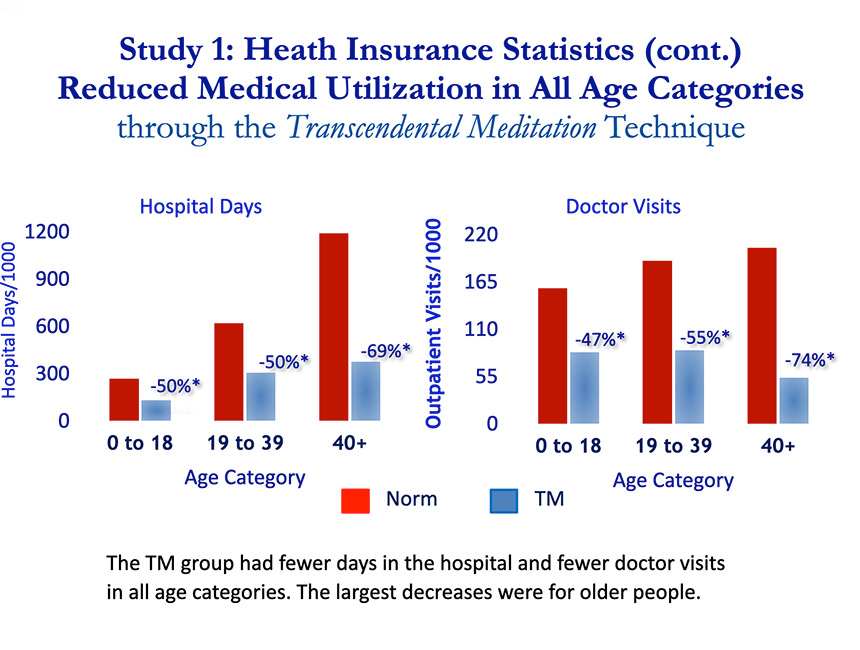
Reference. D. W. Orme-Johnson. “Medical Care Utilization and the Transcendental Meditation Program.” Psychosomatic Medicine 49 (1987): 493-507. Data courtesy of Blue Cross Blue Shield of Iowa.
The chart shows that for people aged 0 to 18 years and 19 to 39 years, the reductions for the TM group were about 50 percent, compared to the norm.
But for people over 40, the reductions were even larger: 69 percent for hospitalization and 74 percent for outpatient doctor visits. Study 2 showed similar large reductions for older people.
Study 1 showed that the TM technique reduced hospitalization and doctor visits in all age groups, with the biggest reductions in the oldest category, those over 40.
Q: Could the TM practitioners in the health insurance study have been healthier before they learned TM?
A: This is a legitimate question. The health insurance studies we’ve discussed were conducted on people who self-selected to take the TM course. That is, they weren’t randomly assigned to do so. Are people who decide to learn TM healthier to begin with? Perhaps they’re already eating wholesome food, exercising daily, not smoking, and following a more healthful lifestyle.
One way to answer this question is to examine whether learning the TM technique plays any role in reducing medical utilization and costs.
A 14-year longitudinal study of medical utilization and costs, using official medical statistics in Quebec, compared 1,418 TM practitioners with 1,418 people matched for age, sex, and region.21 In the eight years prior to learning TM, the medical costs of the TM group were comparable to controls. It was only after they started practicing TM that their medical costs began to drop each year for the next 6 years.

Reference. R. Herron, and K. Cavanaugh. “Can the Transcendental Meditation Program Reduce the Medical Expenditures of Older People? A Longitudinal Cost Reduction Study in Canada.” Journal of Social Behavior and Personality 17 (2005): 415-442.
The chart focuses on people over age 65 (N = 163) for both the TM group and the control group. The people who learned the TM technique (blue line) in fact had slightly higher medical costs than controls before learning, and their costs were rising at about the same rate as controls during the 8-year baseline period.
Once they learned the TM technique, however, their medical costs began to drop, by about 15 percent per year, and were 70 percent lower after 5 years of practicing TM, compared to the controls.
Note that this magnitude of reduction in medical costs is comparable with what is shown in the earlier chart on rates of hospitalization and doctor visits—about 70 percent lower levels of hospitalization and doctor visits for the older age group.
Randomized controlled studies have also shown that TM practice reduces cardiovascular disease22-27 and mortality.28-30 These studies prove that TM has health benefits.
Randomized controlled studies have also shown that TM practice reduces cardiovascular disease and mortality.
Q: Thank you, Dr. Orme-Johnson, this is all very encouraging! Is there anything else you would recommend?
A: It’s always a pleasure to talk about the research showing the profound benefits of practicing the TM technique—now more than ever. These studies show that it’s a great tool for strengthening immunity.
An additional recommendation I would like to make is to stay rested! Go to bed early, take frequent breaks from work (and play). Don’t push yourself. Be kind to your body and let it recover from exertion.
And, of course, the main point from me: Practice the Transcendental Meditation technique regularly, twice a day, in the morning before breakfast and in the evening before dinner.
Best wishes for a healthy you and a healthy, peaceful world!
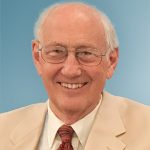 Dr. David Orme-Johnson, one of the principal researchers on the Transcendental Meditation technique worldwide, served as Director of Research of the International Center for Scientific Research, and Vice Chancellor of Maharishi European Research University. At Maharishi International University, Dr. Orme-Johnson was Head of the Psychology Department, Director of the Doctoral Program in Psychology, Co-Director of the Ph.D. program in the Physiology of Human Consciousness, and Dean of Research. As the author of over 100 scientific publications in books, collections, and peer-reviewed journals, he has presented TM research in more than 56 countries, to scientific conferences, high-ranking government officials, and the United Nations. For more about his work and research, visit Dr. Orme-Johnson’s website, TruthAboutTM.org.
Dr. David Orme-Johnson, one of the principal researchers on the Transcendental Meditation technique worldwide, served as Director of Research of the International Center for Scientific Research, and Vice Chancellor of Maharishi European Research University. At Maharishi International University, Dr. Orme-Johnson was Head of the Psychology Department, Director of the Doctoral Program in Psychology, Co-Director of the Ph.D. program in the Physiology of Human Consciousness, and Dean of Research. As the author of over 100 scientific publications in books, collections, and peer-reviewed journals, he has presented TM research in more than 56 countries, to scientific conferences, high-ranking government officials, and the United Nations. For more about his work and research, visit Dr. Orme-Johnson’s website, TruthAboutTM.org.



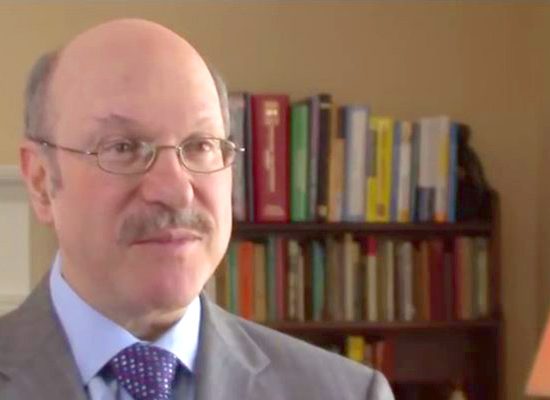


Very impressive! I only can support the research-results as I experience mostly better health-conditions compared with my college class-mates born 1941, 1942. I started TM almost 50 years ago with David Fiske in Capetown.